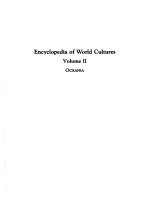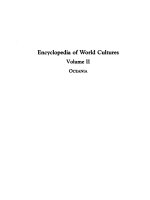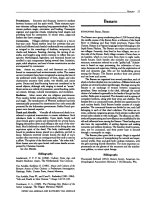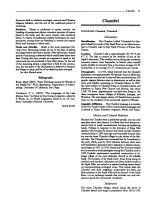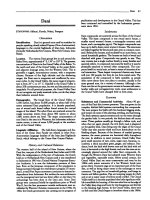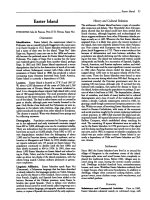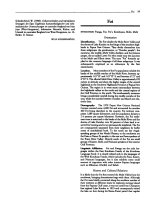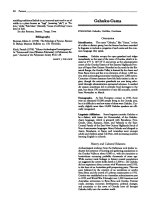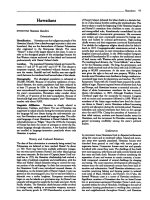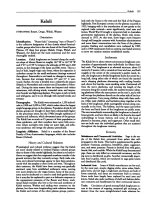Encyclopedia of World Cultures Volume III - South Asia - U,V,Z potx
Bạn đang xem bản rút gọn của tài liệu. Xem và tải ngay bản đầy đủ của tài liệu tại đây (1.01 MB, 10 trang )
Untouchables
299
Untouchables
ETHNONYMS:
Adi-Dravida,
depressed
caste,
external
caste,
Harijan,
Panchama,
Pariah,
Scheduled
Caste
The
word
"Untouchable"
was
first
applied-to
this
cate-
gory
of
Hindus
by
the
Maharaja
Sayaji
Rao
III
of
Baroda
in
a
lecture
he
gave
in
1909,
to
describe
their
most
essential
char-
acteristic
vis-a-vis
higher-ranking
castes.
Some
twenty
years
later
Mahatma
Gandhi
named
them
'Harijans,"
which
means
roughly
'children
of
God."
Later
still
the
government
of
India
drew
up
a
list
of
the
most
disadvantaged
castes,
hence
generating
a
new
euphemism,
'Scheduled
Castes."
Drawing
on
Sanskrit,
Untouchables
have
called
themselves
"Panchama,"
or
the
'fifth
varna,"
a
term
that
is
not
often
heard
today;
or,
in
South
India,
they
are
'Adi-Dravidas,"
meaning
'original
Dravidians."
The
British
have
long
called
them
'Pariahs,"
in
reference
to
a
major
Untouchable
group
of
Tamil
Nadu.
The
Untouchables
are
collectively
all
those
castes,
in
any
part
of
South
Asia,
who
are
Hindus
or
former
Hindus
and
rank
below
the
Sudra
vama.
Their
numbers
are
not
known
precisely,
but
in
1991
India
probably
had
between
130
and
140
million
Untouchables,
and
the
subcontinental
total
would
be
close
to
200
million.
The
low
rank
of
the
Untouchables
is
explained
by
the
general
belief
that
their
traditional
occupations
and
other
habits
are
or
were
polluting
to
higher
castes
in
a
spiritual
way
as
they
had
something
to
do
with
blood,
dirt,
or
death.
Thus
the
families
of
leather
workers,
scavengers,
and
butchers
are
Untouchables,
simply
by
reason
of
their
traditional
occupa-
tions.
Furthermore,
it
is
felt
that
this
karma
comes
to
Un-
touchables
as
a
punishment
for
sins
committed
in
a
previous
existence.
Although
these
numerous
castes
all
fall
below
the
'pollution
line,"
they
are
not
undifferentiated
in
rank
but
rather
recognize
a
range
of
social
distinctions.
Some,
who
rank
higher
than
other
Untouchables,
serve
as
priests
to
the
rest,
at
their
own
shrines,
because
it
is
impossible
to
get
Brah-
mans
or
other
priests
of
very
high
status
to
serve
the
religious
offices
of
these
people.
The
marks
of
their
supposed
pollution
were
traditionally
expressed
in
a
variety
of
ways.
Very
commonly,
a
cheri
or
sepa-
rated,
satellite
hamlet
was
established
for
the
Untouchables
of
a
village;
otherwise,
they
would
inhabit
a
segregated
quar-
ter.
The
use
of
their
own
wells
and
even
in
some
areas
the
use
of
their
own
footpaths
and
bridges
were
thought
to
be
ways
of
protecting
the
rest
of
Hindu
society
from
their
polluting
pres-
ence.
In
Kerala
until
a
century
ago
there
were
various
pre-
scribed
distances,
ranging
from
12
to
96
paces,
closer
than
which
the
particular
Untouchable
castes
could
not
approach
higher-status
Hindus.
Some
were
said
to
be
so
polluting
that
they
could
pollute
a
corpse-itself
considered
highly
polluting-or
should
only
move
around
at
nighttime.
Some
groups
in
Kerala
polluted
a
Hindu
of
higher
caste
if
only
their
shadow
fell
on
him;
others
had
to
actually
touch
him
or
his
food
to
do
so.
In
modem
times
the
requirements
of
public
transporta-
tion
and
daily
living
have
made
many
of
these
observances
anachronistic,
if
not
quite
unthinkable.
Yet
the
Untoucha-
bles
remain
the
most
backward
and
least
educated
sector
of
the
community.
Various
sorts
of
government
uplift
programs
provided
especially
for
the
Scheduled
Castes
have
gone
some
way
toward
improving
the
health,
education,
political
repre-
sentation,
and
employment
opportunities
for
Untouchables.
Yet
they
remain,
in
all
South
Asian
countries,
a
somewhat
de-
spised
and
underprivileged
category.
Sizable
numbers
of
Untouchables
have
over
the
past
century or
so
been
converted
to
Christianity
or
Buddhism,
partly
in
response
to
the
relative
egalitarianism
of
these
faiths,
and
partly
because
membership
in
these
communities
might
obscure
one's
Untouchable
background
and
so
im-
prove
the
chances
for
better
employment.
Untouchability
is
by
no
means
confined
to
South
Asia,
for
it
has
also
been
reported
in
Japan
(the
Buraku),
Korea
(the
Paekchong),
Tibet
(the
Ragyappa),
and
Burma
(Pagoda
slaves);
in
each
case
there
is
no
association
with
Hinduism.
See
also
Castes,
Hindu;
Chamar;
Mahar;
Neo-Buddhist;
Scheduled
Castes
and
Scheduled
Tribes
Bibliography
Fuchs,
Stephen
(1950).
The
Children
of
Hari.
Vienna:
Verlag
Herold.
Mahar,
J.
Michael,
ed.
(1972).
The
Untouchables
in
Contem-
porary
India.
Tucson:
University
of
Arizona
Press.
PAUL
HOCKINGS
300
Vaisya
Vaisya
ETHNONYM:
Vaishya
The
Vaisyas
are
the
third-highest
of
the
four
varnas
or
categories
into
which
Hindu
society
is
traditionally
divided,
ranking
above
the
Sudras.
Vaisya
includes
a
large
number
of
distinct
castes
of
similar
ranking,
traditionally
traders,
moneylenders,
or
farmers.
They
are
entitled
to
wear
a
sacred
thread.
It
is
distinctly
less
common
to
encounter
castes
claim-
ing
Vaisya
status
in
Sri
Lanka
and
south
India
than
in
the
north.
The
category
is
certainly
a
very
ancient
one,
for
it
is
re.
ferred
to
in
the
Rig
Veda
(c.
twelfth
century
B.C.).
Vaisyas
are
clearly
referred
to
in
other
early
hymns
as
being
Aryas,
the
In.
do-European
invaders,
rather
than
Dasas,
the
Dravidian
and
other
Aborigines
of
the
subcontinent.
According
to
the
Zend
Avesta,
the
Zoroastrian
holy
book,
there
was
in
ancient
Persia
a
social
category
called
"Vastrya,"
who
ranked
third
in
society
below
the
Atharvas
and
Rethaesvas
and
bore
a
name
that
is
cognate
with
the
Sanskrit
"Vaisya."
The
classical
Indian
law-
giver
Manu
(c.
second
century
A.D.)
spells
out
the
duties
of
the
Vaisya:
"to
keep
herds
of
cattle,
to
bestow
largesses,
to
sacrifice,
to
read
the
scripture,
to
carry
on
trade,
to
lend
at
in-
terest,
and
to
cultivate
land."
The
economy
depended
on
them,
and
the
description
of
Manu
still
holds
true
See
also
Bania;
Castes,
Hindu
Bibliography
Hutton,
John
H.
(1963).
Caste
In
India.
4th
ed.
London:
Ox-
ford
University
Press.
PAUL
HOCKINGS
Vedda
ETHNONYMS:
Vadda,
Veddah,
Veddha,
Vaddo
Orientation
Identification.
The
Veddas
are
a
small
group
of
people
liv-
ing
in
the
center
of
Sri
Lanka,
an
island
off
the
southern
tip
of
India.
'Vedda"
is
a
Dravidian
word
meaning
"hunter."
Con-
temporary
Vedda
culture
is
strongly
marked
by
prolonged
in-
teraction
both
with
the
Sinhalese
and
with
the
Tamils,
the
two
largest
ethnic
groups
in
Sri
Lanka,
but
the
Vedda
people
themselves
are
generally
reputed
to
be
descended
from
the
aboriginal
population
of
the
island
and
to
have
maintained
until
recent
times
a
distinctive
way
of
life
based
on
hunting
and
gathering.
The
Veddas
are
divided
into
three
regional
groups
(the
Bintenne
Veddas,
the
Anuradhapura
Veddas,
and
the
Coast
Veddas)
whose
members
have
little
or
no
con-
tact
with
one
another,
although
they
acknowledge
a
remote
kinship.
Location.
Sri
Lanka
is
located
between
50
55'
and
90
51'
N
and
790
41'
and
810
53'
E.
Veddas
formerly
lived
in
all
of
the
more
isolated
parts
of
the
island,
but
today
they
are
restricted
to
the
arc
of
country
between
the
predominantly
Sinhalese
areas
in the
west,
south,
and
center
of
the
island
and
the
pre-
dominantly
Tamil
areas
in
the
north
and
east.
The
Bintenne
Veddas
inhabit
an
area
in
the
southeast
of
the
island,
inland
from
the
towns
of
Batticaloa
and
Trincomalee
and
extending
westward
to
the
Verugal,
Mahaweli,
and
Gal
Oya
rivers.
The
Coast
Veddas
live
along
the
coast
between
Batticaloa
and
Trincomalee.
The
Anuradhapura
Veddas
live
in
the
North
Central
Province.
All
three
groups
are
located
within
Sri
Lanka's
dry
zone,
where
the
annual
rainfall
is
normally
less
than
190
centimeters,
most
of
which
falls
between
October
and
December.
Demography.
The
Veddas
constitute
only
a
very
small
proportion
of
the
total
population
of
Sri
Lanka,
which
was
es-
timated
at
nearly
15
million
by
the
1981
census.
There
is,
however,
no
consensus
as
to
just
how
small
this
proportion
is,
because
the
criteria
used
to
identify
the
Veddas
vary
widely.
They
were
last
enumerated
separately
in
the
census
of
1963,
at
which
time
they
numbered
400.
In 1970,
however,
a
census
of
the
Anuradhapura
Veddas,
conducted
as
part
of
an
ethno-
graphic
study,
counted
more
than
6,600
of
them.
The
main
reason
for
this
discrepancy
is
that
government
officials
have
tended
to
treat
as
Veddas
only
those
who
subsist
from
hunt-
ing
and
gathering-a
criterion
that
would
have
excluded
vir-
tually
all
of
the
Anuradhapura
Veddas-while
the
ethnogra-
pher's
census
included
all
those
who
identified
themselves
as
Veddas.
Estimates
of
the
size
of
the
Bintenne
and
Coast
Vedda
populations
are
not
available,
but
both
are
probably
much
less
than
that
of
the
Anuradhapura
Veddas.
Linguistic
Affiliation.
Only
faint
traces
of
what
might
once
have
been
a
distinct
Vedda
language
have
been
de-
tected.
Contemporary
Veddas
speak
colloquial
forms
of
ei-
ther
Sinhala
or
Tamil,
depending
on
which
of
the
two
main
ethnic
groups
predominates
in
their local
area.
The
Bintenne
and
Anuradhapura
Veddas
mostly
speak
Sinhala,
which
is
an
Indo-European
language,
while
the
Coast
Veddas
speak
Tamil,
which
is
Dravidian.
Peculiarities
in
the
speech
pat-
terns
of
the
Veddas
can
be
attributed
to
their
relative
isola-
tion,
low
level
of
formal
education,
and
low
socioeconomic
status.
History
and
Cultural
Relations
The
weight
of
physical
anthropological
evidence
is
that
cer-
tain
groups
of
Veddas
show
stronger
biological
affinities
with
prehistoric
inhabitants
of
the
island
than
do
any
other
groups
in
present-day
Sri
Lanka.
This
lends
support
to
the
common
assertion
that
the
Veddas
are
the
remnant
descendants
of
an
aboriginal
population
that
inhabited
Sri
Lanka
before
the
emergence
of
a
literate
civilization
in
the
later
centuries
of
the
first
millennium
B.C.
The
extent
to
which
this
civilization
was
an
indigenous
development
and
not
just
the
creation
of
im-
migrant
settlers
remains
a
matter
of
controversy,
but
un-
doubtedly
there
was
considerable
exchange-both
cultural
and
genetic-between
the
descendants
of
the
prehistoric
in-
Vedda
301
habitants
and
later
immigrants.
These
relations
are
expressed
in
the
popular
myth
that
the
contemporary
Veddas
are
de-
scended
from
a
union
between
Kuveni,
an
aboriginal
demoness,
and
Prince
Vijaya,
the
legendary
founder
of
the
Sinhalese
nation
who
came
from
India.
In
historic
times,
however,
the
most
prominent
feature-virtually
the
defining
characteristic-of
the
Veddas
has
been
their
social
marginal-
ity.
They
have
made
their
living
on
the
peripheries
of
Sinhalese
and
Tamil
polities,
in
relation
to
both
of
which
they
came
to
represent
the
uncivilized
element
in
society.
Thus
while
actual
Vedda
culture
reveals
a
variable
pattern
that
merges
readily
with
that
of
the
rural
Sinhalese,
the
cate-
gorical
opposition
between
Vedda
and
Sinhalese
radically
distinguishes
the
former,
as
a
group
of
savage
and
pagan
for-
agers,
from
the
more
civilized,
paddy-cultivating
Buddhist
Sinhalese.
A
similar
pattern
obtains
between
the
Tamil-
speaking
Coast
Veddas
and
the
Hindu
Tamils.
In
the
last
hundred
years,
however,
with
the
rapid
expansion
of
Sri
Lanka's
population,
improved
communications,
and
in-
creased
settlement
in
the
dry
zone,
embodiments
of
the
ideal
or
typical
Vedda,
defined
in
polar
opposition
to
the
civilized
Sinhalese
or
Tamil,
have
become
extremely
hard
to
find.
Nevertheless,
because
of
its
compatibility
with
the
disposi-
tion
of
nineteenth-century
European
scholars
to
discover
a
pristine
Vedda
culture
that
was
unambiguously
associated
with
a
distinct
racial
group,
this
idealized
representation
of
the
Vedda
has
exercised
a
commanding
influence
over
the
anthropological
imagination.
Recent
studies
of
the
Anuradhapura
and
Coast
Veddas
have
encompassed
groups
that
deviate
significantly
from
the
ideal,
but
representations
of
the
Bintenne
Veddas
are
still
dominated
by
C.
G.
and
Brenda
Seligmann's
classic
study,
published
in
1911,
which,
in
its
ambition
to
describe
the
pure
culture
of
pure-blooded
Veddas,
depicts
a
way
of
life
that
was
followed
only
by
a
small
minority
of
those
who
then
identified
themselves
as
Veddas.
Settlements
According
to
the
Seligmanns,
Bintenne
Veddas
lived
both
in
permanent
villages
of
up
to
40
families
and
in
temporary
set-
tlements,
near
their
cultivation
plots,
which
contained
be-
tween
1
and
5
families
of
varying
size.
The
Anuradhapura
Veddas
occupy
32
villages
and
14
satellite
hamlets
that
are
scattered
among
the
much
more
numerous
Sinhalese
villages
in
the
region.
In
1970
their
largest
village
had
a
population
of
552.
Their
settlement
pattern
is
similar
to
that
of
the
local
Sinhalese,
the
core
of
the
village
being
a
cluster
of
houses
built
close
to
the
village
reservoir.
The
Coast
Veddas
live
in
small
villages
near
the
sea
consisting
of
a
cluster
of
com-
pounds
with
two
or
three
houses
to
a
compound.
Some
of
the
Bintenne
Veddas
are
reported
to
have
been
cave
dwellers
for-
merly,
but
by
the
Seligmanns'
time
they
were
mostly
living
in
huts
made
of
wattle
and
daub
or
in
more
temporary
shelters
consisting
of
a
wooden
frame
covered
with
animal
skins,
bark,
and/or
leaves.
The
Anuradhapura
Veddas
live
in
wattle-and-
daub
houses
with
floors
of
packed
earth.
Coast
Vedda
houses
are
simple
huts
made
of
plaited
palm.
Some
Veddas
have
re-
cently
received
government-subsidized
housing
built
of
brick
and
plaster
with
concrete
floors
and
tin
roofs.
Economy
Subsistence
and
Commercial
Activities.
The
distinction
between
"Wild,"
'Jungle,"
or
'Rock
Veddas,"
who
live
from
hunting
and
gathering
and
sometimes
also
shifting
cultiva-
tion,
and
'Village
Veddas,"
who
live
in
permanent
settle-
ments
and
subsist
principally
from
cultivation,
is
long
estab-
lished,
but
already
by
the
time
of
the
Seligmanns'
study
there
were
very
few
Veddas
who
lived
principally
from
foraging.
The
Anuradhapura
Veddas
until
recently
have
derived
their
living
mainly
from
shifting
cultivation,
supplemented
where
possi-
ble
by
wet-rice
agriculture.
Crops
grown
under
shifting
culti-
vation
include
millet,
maize,
beans,
squashes,
manioc,
chilies,
eggplants,
tomatoes,
and
okra.
Under
present
conditions
of
rapidly
increasing
population
pressure
and
greater
market
in-
volvement,
many
of
the
Anuradhapura
Veddas
now
obtain
the
major
part
of
their
livelihood
as
agricultural
wage
laborers
outside
their
own
villages.
At
the
same
time
an
increasing
proportion
of
what
they
produce
in
their
own
fields
is
now
marketed
rather
than
consumed
at
home.
Coast
Veddas
put
a
greater
emphasis
on
fishing,
combining
this
with
shifting
cul-
tivation
and,
less
frequently,
paddy
cultivation.
Fishing
is
done
with
nets
cast
from
outrigger
canoes,
from
rafts,
or
from
platforms
set
up
in
the
surf.
Prawns
are
the
principal
catch.
Like the
Anuradhapura
Veddas,
many
Coast
Veddas
now
also
work
as
casual
wage
laborers.
A
few
individuals
in
all
three
groups
hunt
occasionally
as
a
means
of
supplementing
their
income.
Some
Veddas
also
collect
wild
honey,
one
of
their
traditionally
ascribed
occupations.
Veddas
keep
cattle,
water
buffalo,
goats,
chickens,
and
dogs,
although
the
relative
importance
of
these
species
varies
greatly
between
different
communities.
Industrial
Arts.
The
Bintenne
Veddas
formerly
made
most
of
their
own
hunting
equipment,
such
as
bows
and
ar-
rows,
spears,
axes,
etc.,
although
by
1900
those
who
hunted
had
already
come
to
rely
on
metal
for
the
heads
of
their
spears,
arrows,
and
axes,
which
they
obtained
through
barter.
Some
had
even
begun
to
use
guns
to
bring
down
their
prey.
The
Anuradhapura
Veddas
obtain
their
agricultural
tools
in
the
market,
as
do
the
Coast
Veddas.
The
Coast
Veddas
are,
however,
capable
boat
builders.
Trade.
The
Bintenne
Veddas
are
reputed
at
one
time
to
have
engaged
in
"silent
trade"
with
the
Sinhalese.
Exchange
relations
among
the
Veddas
were
formerly
governed
princi-
pally
by
rules
of
reciprocity,
but
in
the
last
few
decades
all
groups
have
become
much
more
deeply
involved
in
market
re-
lations.
Only
a
few
Veddas,
however,
have
successfully
estab-
lished
themselves
as
traders
or
shopkeepers.
Division
of
Labor.
Men
do
most
of
the
agricultural
work,
especially
in
paddy
cultivation,
while
women
gather
wild
foods
and
firewood,
cook,
care
for
children,
tend
domestic
gardens,
and
assist
in
shifting
cultivation
and
harvesting
paddy.
Among
the
Coast
Veddas
men
do
most
of
the
fishing.
Both
male
and
female
Veddas
engage
in
wage
labor.
Occupa-
tional
specialization
and
economic
differentiation
between
households
are
not
pronounced.
Land
Tenure.
Access
to
irrigated
land
is
normatively
ob-
tained
by
inheritance,
but
sales
and
mortgages
are
common.
Most
of
the
jungle
land
on
which
shifting
cultivation
is
prac-
ticed
is
claimed
by
the
state,
but
Veddas
see
it
as
the
commu-
nal
property
of
the
village
it
surrounds.
Rapid
population
302
Vedda
growth
and
the
shift
to
cash
cropping
have
intensified
pres-
sure
on
the
land,
resulting
in
increased
landlessness
and
a
dangerous
reduction
of
the
fallow
period
in
shifting
cultiva-
tion.
A
few
Veddas
have
obtained
land
in
development
proj-
ects
funded
by
the
state.
Some
Bintenne
Veddas
who
claim
still
to
live
from
hunting
and
gathering
have
joined
a
move-
ment
to
have
a
Vedda
reservation
established
in
the
region.
Kinship
Kin
Groups
and
Descent.
The
Seligmanns'
claim
that
the
Bintenne
Veddas
practiced
matrilineal
descent
has
been
strongly
challenged
by
other
researchers.
The
Anuradhapura
Veddas
reckon
kinship
bilaterally.
Above
the
level
of
the
household
their
significant
kin
groups
are
the
village
commu-
nity,
all
the
members
of
which
consider
one
another
to
be
their
kin,
and
the
variga,
a
largely
endogamous
grouping
that
includes
all
the
Anuradhapura
Veddas.
The
Coast
Veddas
also
reckon
kinship
bilaterally,
but
they
do
not
recognize
variga
as
a
cultural
category
for
regulating
descent
and
mar-
riage.
They
do,
however,
see
themselves
as
related
to
all
other
Veddas
in
the
vicinity
and
generally
marry
among
themselves,
forming
loosely
structured
kindred
groups.
Traces
of
matrilineal
descent
and
clan
organization
have
also
been
noted
among
the
Coast
Veddas.
Kinship
Terminology.
Kinship
terminology
is
Dravidian,
both
among
the
Sinhala-speaking
and
the
Tamil-speaking
Veddas.
Marriage
and
Family
Marriage.
As
is
implied
by
Dravidian
kinship terminology,
the
Veddas
practice
classificatory
cross-cousin
marriage.
Among
the
Anuradhapura
Veddas
approximately
15
percent
of
marriages
are
between
first
cross
cousins.
The
percentage
is
lower
among
the
Coast
Veddas,
who
also
intermarry
with
outsiders
more
frequently
than
do
the
Anuradhapura
Veddas.
Almost
all
marriages
within
all
three
groups
of
Veddas
are
monogamous.
The
independent
family
household
is
the
ideal.
Most
newly
married
couples,
however,
live
for
a
while
either
in
or
close
to
the
household
of
one
of
their
par-
ents.
Divorce
is
common
in
the
early
years
of
marriage.
Domestic
Unit.
Among
the
Anuradhapura
and
Coast
Veddas
the
normal
unit
is
the
nuclear
family
household
whose
members
work
together
and
eat
from
the
same
hearth.
Among
the
Bintenne
Veddas,
it
is
common
to
find
more
than
one
related
family
living
in
the
same
shelter
or
house.
Inheritance.
All
sons
and
daughters
have
equal
rights
of
inheritance,
but
among
the
Bintenne
Veddas
the
daughter's
inheritance,
usually
land,
is
typically
given
to
her
husband
at
the
time
of
marriage,
although
this
is
not
specifically
referred
to
as
dowry.
Dowry
is
not
significant
among
the
Veddas
as
a
whole,
although
some
wealthier
Veddas
in
all
three
groups
give
it
in
emulation
of
higher
status
Tamil
or
Sinhalese
fami-
lies
living
in
the
vicinity.
Socialization.
Children
are
raised
by
parents
and
older
sib-
lings.
Vedda
children
have
comparatively
poor
access
to
the
educational
institutions
in
Sri
Lanka.
Sociopolitical
Organization
Social
Organization.
Social
relations
within
Vedda
vil-
lages
are
structured
mainly
by
rules
of
kinship.
Apart
from
hi-
erarchies
of
age
and
gender,
social
relations
are
generally
egal-
itarian.
Caste
also
plays
a
role
in
regulating
interaction
between
Veddas
and
their
Tamil
and
Sinhalese
neighbors,
at
least
in
the
Anuradhapura
and
Coast
regions.
The
caste
spe-
cialization
of
the
Veddas
has
been
identified
both
as
hunting
and
as
spirit
mediumship,
although
it is
also
claimed
that
the
Veddas
stand
entirely
outside
either
the
Sinhalese
or
the
Tamil
caste
system
since
they
lack
formal
structural
ties
with
other
castes.
The
Anuradhapura
Veddas
collectively
consti-
tute
a
single
variga
(caste
or
subcaste),
but
their
variga
court,
which
used
to
regulate
internal
caste
affairs,
has
not
func-
tioned
since
the
1950s.
The
Coast
and
Bintenne
Veddas
have
apparently
never
had
any
kind
of
overarching
caste
court.
Political
Organization.
The
Veddas
formerly
enjoyed
con-
siderable
autonomy,
being
located
at
or
beyond
the
effective
limits
of
Sinhalese
or
Tamil
political
power.
Within
the
vil-
lages
leadership
was
provided
by
influential
male
elders.
The
Veddas
were
increasingly
subordinated
to
state
authority
dur-
ing
the
period
of
British
colonial
rule,
a
trend
that
has
inten-
sified
since
Sri
Lanka
became
independent
in
1948.
Agricul.
tural
cooperatives,
development
societies,
and
other
state-
sponsored
organizations
have
been
established
in
many
villages.
In
Anuradhapura
and
Bintenne
the
local
officers
of
these
organizations
often
are
village
leaders,
but
among
the
Coast
Veddas
the
leadership
is
nearly
always
provided
from
among
the
Tamil
elite
in
nearby
Tamil
villages.
Social
Control.
Everyday
social
life
in
Vedda
villages
is
still
largely
governed
by
norms
of
kinship,
although
recourse
is
also
made
to
state
officials,
and
the
police
are
a
more
fre-
quent
presence
than
in
the
past.
Sorcery
accusations
can
also
act as
an
informal
means
of
social
control.
Conflict.
Competition
between
kin-based
factions
has
long
been
a
prominent
feature
of
village
life.
The
Coast
Veddas
usually
participate
in
local
politics
as
subordinate
members
of
Tamil-led
factions.
Today
factional
struggles
typ-
ically
appear
in
the
guise
of
conflict
between
the
local
branches
of
the
national
political
parties
and
focus
on
the
distribution
of
welfare
and
development
resources.
Religion
and
Expressive
Culture
Religious
Beliefs.
The
religious
beliefs
of
the
Veddas
over-
lap
considerably
with
those
of
Sinhalese
villagers,
who
are
predominantly
Buddhists,
and
with
those
of
Tamil
villagers,
who
are
mostly
Hindus.
All
worship
a
hierarchical
pantheon
of
deities,
to
whom
offerings
are
made
in
the
hope
of
gaining
favors
or
relief
from
suffering.
As
described
by
the
Selig-
manns,
the
Bintenne
Veddas
had
no
knowledge
of
Bud-
dhism.
Their
religion
was
apparently
based
on
worship
of
re-
cently
deceased
ancestors,
various
local
demons,
and
other
minor
gods.
In
contrast,
the
Anuradhapura
Veddas
describe
themselves
as
Buddhists,
although
their
participation
in
Bud-
dhist
rites
is
infrequent.
The
Coast
Veddas
are
more
influ-
enced
by
their
Hindu
Tamil
neighbors
and
engage
in
various
forms
of
temple
worship
associated
with
Hindu
deities,
as
well
as
propitiating
local
deities
and
demon
spirits.
The
pan-
theon
extends
from
locally
resident
spirits
and
demons
whose
Vellala
303
disposition
is
generally
malevolent
to
powerful
and
benevo-
lent,
but
more
remote,
major
gods.
For
those
who
profess
Buddhism,
these
major
gods
themselves
derive
their
authority
from
the
Buddha.
The
most
important
high
gods
for
the
Anuradhapura
Veddas
are
Kataragama
and
Pulleyar.
For
the
Coast
Veddas
they
are
Shiva,
Murugan,
Pillaiyar,
and
Valli.
The
Bintenne
Veddas
cut
off
the
hierarchy
at
a
lower
level
and
attend
only
to
more
localized
gods,
demons,
and
ancestor
spirits,
although
a
few
also
worship
the
high
god
Kataragama.
Religious
Practitioners.
Among
the
Anuradhapura
and
Bintenne
Veddas
one
of
the
most
important
religious
practi-
tioners
is
the
kapurala,
who
intercedes
with
a
god
on
behalf
of
his
fellow
villagers.
Among
the
Anuradhapura
Veddas
there
is
also
the
anumatirala,
who
becomes
possessed
by
a
minor
god
or
demon
and
performs
exorcisms.
Specialized
religious
practitioners
are
rare
among
the
Coast
Veddas.
Ceremonies.
The
Bintenne
Veddas
engage
in
many
differ-
ent
ceremonial
dances
in
which
a
specialized
practitioner
be-
comes
possessed
by
a
god
or
demon.
These
dances
are
always
a
part
of
an
exorcism
or
an
attempt
to
procure
favors
or
infor-
mation
from
the
spirit
being.
The
Anuradhapura
Veddas
hold
an
annual
ceremony
at
which
offerings
are
made
collec-
tively
to
the
village's
tutelary
deity.
Other
ceremonies,
such
as
exorcisms,
are
organized
by
individual
households.
The
Coast
Veddas
observe
the
Hindu
festival
calendar,
but
their
most
important
rituals
are
locally
organized
possession
ceremonies,
which
are
conducted
jointly
by
all
concerned
Vedda
villagers.
Personal
rites
of
propitiation
and
protection
are
also
common
among
all
groups
of
Veddas.
Arts.
Ritual
performances,
especially
possession
ceremo-
nies
that
include
dancing,
chanting,
instrumental
music
mak-
ing,
and
the
construction
of
temporary
shrines,
provide
some
of
the
principal
occasions
for
artistic
expression
among
all
Vedda
groups.
The
plastic
arts
are
otherwise
little
emphasized
beyond
acts
of
individual
decoration.
The
Seligmanns
noted
that
the
Bintenne
Veddas
were
once
adept
at
making
artifacts
and
utensils
from
animal
skins
and
also
engaged
in
rock
and
cave
drawings.
Singing
is
a
popular
form
of
recreation
among
the
Veddas.
Medicine.
Persons
familiar
with
at
least
some
aspects
of
the
South
Asian
tradition
of
Ayurvedic
medicine
are
found
among
both
the
Anuradhapura
and
the
Coast
Veddas.
They
use
herbal
compounds
to
adjust
the
balance
of
humors
in
the
body.
Some
illnesses
are
attributed
to
demonic
possession
and
are
treated
by
exorcism.
Among
the
Bintenne
Veddas,
al-
most
all
illness
was
treated
through
ritual
ceremonies.
Many
Veddas
now
have
access
to
the
free
medical
care,
based
on
Western
science
and
technology,
that
is
provided
by
the
state.
Death
and
Afterlife.
Among
the
Anuradhapura
and
Coast
Veddas,
beliefs
and
practices
regarding
death
are
shaped
by
Buddhist
and
Hindu
concepts
of
karma,
reincarna-
tion,
and
the
transmigration
of
souls.
The
Bintenne
and
the
Coast
Veddas
also
practice
rituals
to
propitiate
and
commu-
nicate
with
recently
deceased
ancestors
who
are
believed
to
be
able
to
influence
events
in
the
present
life.
See
also
Sinhalese;
Tamil
of
Sri
Lanka
Bibliography
Brow,
James
(1978).
Vedda
Villages
of
Anuradhapura
District:
The
Historical
Anthropology
of
a
Community
in
Sri
Lanka.
Seattle
and
London:
University
of
Washington
Press.
Dart,
Jon
(1985).
"Ethnic
Identity
and
Marginality
among
the
Coast
Veddas
of
Sri
Lanka."
Ph.D.
dissertation,
Univer-
sity
of
California,
San
Diego.
Kennedy,
K.
A.
R.,
W.
F.
Roertgen,
J.
Chiment,
and
T.
Disotell
(1987).
"Upper
Pleistocene
Fossil
Hominids
from
Sri
Lanka."
American
Journal
of
Physical
Anthropology
72:441-461.
Seligmann,
C.
G.,
and
Brenda
Seligmann
(1911).
The
Veddas.
Cambridge:
Cambridge
University
Press.
JAMES
BROW
AND
MICHAEL
WOOST
Vellala
ETHNONYMS:
Mudaliar,
Pandaram,
Pillaimar
(Pillai),
Velalar
(Velalan)
Orientation
Identification.
The
Vellala
are
a
major
agricultural
caste
who
live
in
Tamil
Nadu,
a
state
ofsouthern
India.
They
speak
Tamil
and
are
Hindu.
The
Velama
and
Ballal
castes
of
the
neighboring
states
of
Andhra
Pradesh
and
Karnataka,
respec-
tively,
are
believed
to
be
historically
related
to
the
Vellala,
but
at
present
the
three
groups
are
separate
and
distinct.
The
Vellala
are
divided
on
a
territorial
basis
and
subdivided
fur-
ther
into
endogamous
jatis
or
subcastes.
As
an
integral
part
of
an
intercaste
network,
both
ideologically
and
in
daily
life,
Vellala
culture
is
not
an
independent
entity.
It
can
be
under-
stood
only
in
relation
to
other
castes.
The
Vellala
are
a
large
heterogeneous
category
into
which
several
upwardly
mobile
subcastes
have
successfully
assimilated,
at
various
points
in
time.
They
have
done
so
by
imitating
a
Vellala
life-style.
A
popular
saying
throughout
Tamil
Nadu
is:
"Kallar,
Maravar,
Ahamudayar
[three
castes
that
rank
lower
than
Vellalal
grad-
ually
become
Vellalar."
Hence
identity
is
a
matter
of
great
concern
to
"true"
Vellala
subcastes
who
take
enormous
pains
to
keep
their
purity
intact
through
strict
endogamy,
extreme
caution
when
forming
marriage
alliances,
restrictions
on
women,
and
so
forth.
Broadly,
the
numerous
Vellala
subcastes
constitute
two
major
categories
ranked
hierarchi-
cally.
Usually
a
subcaste's
name
has
a
prefix
denoting
a
place,
a
further
prefix,
and
an
honorific
suffix
used
in
a
particular
re-
gion,
together
forming
a
term
such
as
"Tondaimandalam
Kondaikatti
Vellala
Mudaliar."
Location.
The
Vellala
live
throughout
Tamil
Nadu.
Differ-
ent
subcastes
are
localized
in
different
regions.
For
example,
Mudaliar
subcastes
are
prominent
in
Tondaimandalam
(with
304
Vellala
a
concentration
in
Chinglepet),
Choliya
Pilli
and
Karkattar
in
Cholamandalam
(concentrated
in
Thanjavur),
Kongu
Vellala
or
Kavundar
in
Kongumandalam
(concentrated
in
Coimbatore),
and
Saiva
Pillaimar,
Karkattar,
and
Nangudi
Vellala
in
Pandimandalam
(concentrated
in
Madurai
and
Tirunelveli).
In
general,
the
first
category
of
Vellala
(who
often
call
themselves
vegetarian
Vellala)
predominate
in
the
paddy-growing
river-valley
regions.
Demography.
Since
the
Vellala
are
heterogeneous
and
live
in
multicaste
environments,
an
estimate
of
the
popula-
tion
is
difficult.
Current
censuses
do
not
provide
statistics
by
caste.
In
some
of
the
British
period
census
reports,
caste
fig-
ures
were
given
for
some
districts,
and
the
Vellala
constituted
about
10
percent
of
the
population.
However,
the
criteria
for
defining
Vellala
seems
to
vary
and
there
is
no
clear
basis
for
interdistrict
comparison.
linguistic
Affiliation.
Among
the
living
Dravidian
lan-
guages,
Tamil
has
the
oldest
recorded
history
and
classical
lit-
erary
tradition.
It
is
closely
related
to
Telugu,
Kannada,
and
Malayalam,
which
are
spoken
in
the
neighboring
states.
(Dravidian
languages
are
also
spoken
in
small
pockets
in
cen-
tral
and
eastern
India,
and
in
Pakistan.)
The
contemporary
Tamil
script
is
derived
from
the
Brahmi
script,
which
is
also
the
source
for
the
scripts
of
the
Indo-Aryan
Language
Group.
The
Vellala
speak
a
dialect
that
is
common
among
high-caste
non-Brahmans
in
Tamil
Nadu.
It
is
different
from
the
highly
Sanskritized
language
of
the
Brahmans
and
also
from
the
lan-
guage
of
the
lowest
castes.
The
Vellala
of
different
districts
flavor
their
speech
with
the
local
dialects.
History
and
Cultural
Relations
Most
Vellala
subcastes
share
broadly
similar
origin
myths
that
stress
their
links
with
the
soil
as
agriculturists
(as
con-
trasted
with
artisans),
their
origin
in
the
Ganga
(Gangetic
Valley)
and
migration
from
northern
to
southern
India
dur-
ing
the
distant
past,
and
their
close
relationship
with
the
three
ancient
Tamil
dynasties-Chera,
Chola,
and
Pan-
dya-in
spite
of
the
Vellalas'
ineligibility
for
kingship.
There
is
fairly
strong
literary
and
archeological
evidence
linking
core
Vellala
subcastes
with
a
group
of
chieftains
called
velir;
the
earliest
references
are
found
in
the
Sangam
literature
(first
to
third
century
A.D.).
Until
about
the
fourteenth
century
A.D.,
the
velir
were
prominent
in
the
Tamil
polity,
economy,
and
society,
and
they
have
been
linked
with
virtually
all
the
major
ruling
dynasties.
They
were
autonomous
and
collectively
wielded
significant
political
influence.
Although
ineligible
to
be
crowned
as
kings,
they
were
bride
givers
to
the
three
.crowned"
kings.
They
were
active
militarily
but
also
had
a
strong
base
as
landholders
of
fertile,
paddy-growing
tracts.
They
were
celebrated
for
their
large
and
lavish
charities
and
for
their
patronage
of
literature
and
poetry.
In
the
post-
Sangam
period,
velir
autonomy
decreased,
although
they
continued
as
feudatories,
with
key
civic
and
military
posi-
tions.
Their
position
as
a
landed
elite
with
military
and
ad.
ministrative
power
continued
through
the
subsequent
periods-the
Nayak,
the
Nawab
of
Arcot,
and
the
British.
The
Vellala
served
as
revenue
officers,
temple
trustees
and
managers,
magistrates,
administrative
agents,
rentiers,
village
chiefs,
and
village
accountants.
The
literary
sources
on
the
Vellala
make
a
distinction
between
those
"who
eat
by
plowing
the
land"
and
those
"who
eat
by
getting
the
land
plowed
(through
others)."
Even
now,
this
distinction
serves
as
an
index
of
internal hierarchical
differentiation.
Settlements
The
Vellala
live
in
all
the
districts
of
the
state
and
in
both
urban
and
rural
areas.
In
the
latter,
the
settlement
pattern
is
typically
multicaste
villages.
Depending
on
the
region,
the
Vellala
may
be
the
dominant
caste,
may
share
dominance
with
another
caste,
or
may
be
a
minority.
In
villages
along
the
river
basins,
where
wet
rice
cultivation
is
prominent,
the
dom-
inant
caste
is
often
Vellala
(of
either
category).
Within
a
vil-
lage,
each
Vellala
subcaste,
as
indeed
every
subcaste,
tends
to
live
in
a
separate
street.
In
larger
villages
and
towns,
this
pat-
tern
gets
blurred.
There
is
no
one
distinct
style
of
Vellala
housing
because
house
style
is
a
function
ofwealth
and
loca-
tion
(rural
or
urban).
Economy
Most
Vellala
are
engaged
in
agriculture
full-time
or
as
a
side
occupation.
In
areas
of
wet
paddy
cultivation,
traditional
techniques
continue
to
be
popular,
both
among
small
peas-
ants
and
among
noncultivating
landholders
who
lease
out
to
tenants.
However,
use
of
high-yielding
varieties
of
seeds
and
chemical
fertilizers
is
quite
widespread.
Tenancy
is
less
fa-
vored
now,
because
of
the
difficulties
of
getting
the
land
back
from
tenants,
but
the
traditional
norm
of
having
men
and
women
of
Untouchable
castes
perform
the
major
labor
is
still
intact.
Some
mechanization
has
been
introduced
by
large
landowners
who
have
stopped
tenanting
out
and
started
di-
rectly
overseeing
farming.
Landholding
Vellala
had,
in
the
past,
an
elaborate
and
complex
patron-client
relationship
with
subcastes
who
worked
for
them-both
agricultural
subcastes
as
well
as
artisan
and
service
subcastes
like
priests,
potters,
barbers,
etc.
The
relationship,
in
which
economic
and
ritual
dimensions
are
fused,
approximates
the
jajmani
re-
lations
that
have
been
documented
for
other
regions
in
India.
Elements
of
jajmani
continue
to
the
present
day.
In
areas
where
the
Vellala
of
the
second
category
predominate,
cash
crops,
peasant
proprietorship,
and
commercial
agriculture
are
more
common
and
there
is
greater
mechanization.
Women
from
the
first
category
do
not
work
in
the
fields.
In
the
sec-
ond,
involvement
with
one's
own
family
land
is
not
uncom-
mon,
though
working
on
another's
field
is
considered
unde-
sirable
and
resorted
to
only
in
cases
of
extreme
poverty.
For
various
reasons,
chief
among
which
is
the
government's
land
reform
policy,
a
sizable
section
of
Vellala
of
the
first
category
have
taken
to
higher
education
and
urban
professional
em-
ployment;
however,
they
are
less
likely
to
enter
entre-
preneurial
activities
today
than
in
the
past.
Kinship
Kin
Groups
and
Descent.
The
predominant
Hindu
pat-
tern
of
patrilineal,
patrivirilocal
kinship
in
descent,
inheri-
tance,
succession,
and
residence
is
the
norm among
the
Vellala.
Exceptions
are
the
Nangudi
Vellala
and
Kottai
Pillaimar,
who
have
matrilineal
descent,
patri-matrilineal
in-
heritance,
and
uxorilocal
residence.
Exogamous
units
called
gotram,
membership
in
which
is
traced
from
a
common
ances-
tor
or
place,
are
found
in
some
subcastes
of
the
first
category.
Vellala
305
In
other
subcastes,
the
unit
is
called
kilai.
Members
may
be
scattered
over
several
villages.
The
local
branch
of
the
exogamous
unit
acts
as
a
corporate
entity
for
certain
eco-
nomic
and
ceremonial
functions.
Kinship
Terminology.
Kin
terms
follow
the
Dravidian
system.
Marriage
and
Family
Marriage.
Although
polygynous
marriages
were
permitted
and
prevalent
in
the
past,
most
marriages
today
are
monoga-
mous.
With
a
few
urban
exceptions,
marriage
is
usually
ar-
ranged
by
elders,
although
some
expression
of
disapproval
may
be
available
to
the
youth.
The
Dravidian
pattern
of
pref-
erential
cross-cousin
(both
matrilateral
and
patrilateral)
and
maternal
uncle-niece
marriage
is
strongly
adhered
to.
A
breach
of
this
norm
often
leads
to
an
acrimonious
dispute
be-
tween
families.
Even
traditionally,
prepuberty
or
child
mar-
riage
was
not
prevalent.
Widow
remarriage
is
not
approved
of,
although
it is
now
legal.
Traditionally,
divorce
was
not
per-
mitted.
Despite
modifications
in
Hindu
law,
divorce
is
still
infrequent.
Domestic
Unit.
Various
degrees
of
complexity
of
the
ex-
tended
patrilocal
household
are
found
both
across
Vellala
subcastes
and
within
any
single
Vellala
subcaste.
The
neolocal
or
nuclear
household
is
not
uncommon,
but
it is
em-
bedded
within
the
matrix
of
patrilineal
kinship.
It
is
thus
dif-
ferent
in
character
from
the
Western
ideal
type
of
nuclearity.
Although
patrilineal
kinship
places
women
in
a
weak
struc-
tural
position,
there
are
aspects
of
the
kinship
system
that
leaven
this
situation.
Upon
marrying,
a
woman
may
join
a
family
already
related
and
known
to
her,
she
often
lives
in
her
natal
village,
and
her
natal
and
affinal
relatives
are
continu-
ally
interacting;
all
of
these
factors
support
her
position
in
the
family.
Inheritance.
This
follows
the
general
principle
of
classical
Hindu
law,
where
land
and
immovables
are
inherited
by
sons.
Daughters
are
given
a
dowry
at
marriage.
Sometimes
women
are
given
small
gifts
of
land
(manjal-kani)
but
these
are
not
treated
as
shares.
One
of
the
reasons
for
their
strict
endogamy
and
high
rate
of
consanguineous
marriage,
say
the
Vellala,
is
their
strong
need
to
keep
land
in
the
family.
Sociopolitical
Organization
Social
Organization.
The
relation
of
the
Vellala
to
other
castes
as
well
as
Vellala
internal
ideology
must
be
understood
as
both
influencing
all
aspects
of
Vellala
economic,
political,
religious,
and
kinship
activities.
The
schematic
division
of
Indian
society
into
four
hierarchical
varnas
(castes)
-
Brahman,
Kshatriya,
Vaisya,
and
Sudra-does
not
accurately
reflect
the
situation
in
Tamil
Nadu.
While
the
Brahmans
rank
at
the
top
and
the
Untouchables
or
Scheduled
Castes
at
the
bottom,
between
these
two
extremes
are
a
wide
range
of
castes
and
subcastes
whose
exact
standing
in
relation
to
one
another
depends
on
the
region
and
the
village.
Generally,
a
distinction
is
made
between
'clean"
non-Brahmans,
who
adopt
a
Sanskritized
life-style,
and
the
others.
The
former
are
vegetarians,
do
not
drink
alcohol,
eschew
manual
labor
in-
cluding
plowing
(if
they
are
agriculturalists),
and
have
very
conservative
attitudes
and
customs
regarding
women.
The
other
category
of
upper
non-Brahmans
conforms
to
the
Kshatriya
ideal,
which
emphasizes
manual
strength,
a
land
base,
command
over
labor,
political
authority,
more
interac-
tion
with
other
castes,
and
so
on.
Although
there
is
a
greater
emphasis
on
warriorlike
qualities
than
on
ritual
status,
con-
cern
with
women's
purity
is
high,
especially
in
groups
that
were
connected
to
royal
dynasties
of
the
past.
In
the
twofold
division
of
the
Vellala,
the
second
category
(e.g.,
Kavundar,
Nangudi
Vellala,
Tuluva
Vellala)
falls
clearly
into
the
Kshatriya
model.
The
first
category
(e.g.,
Kondaikatti
Vellala,
Karkattar,
Saiva
Pillaimar)
combines
aspects
of
the
two
mod-
els:
(1)
high
ritual
status
expressed
through
strict
rules
of
interdining
and
intermarriage
(according
to
a
popular
prov-
erb,
the
Vellala
are
more
orthodox
than
Brahmans),
and
(2)
land
base
and
political
visibility
(in
traditional
society).
Thus
the
two
Vellala
categories
occupy
different
structural
posi-
tions
in
the
social
order.
Political
Organization.
The
Vellala
were,
in
the
past,
prominent
in
political
networks
constituted
by
the
court,
temple,
and
caste
councils.
They
maintained
their
domi-
nance
through
endowments
to
temples,
charity
to
the
poor,
and
patronage
of
the
labor
and
service
castes.
In
attempting
to
convert
this
prominence
to
secular
political
status,
they
have
had
mixed
success.
Often,
they
have
been
pushed
out
by
lower
castes,
whose
collective
ethriic
identity
is
perhaps
stronger.
The
Vellalas'
internal
hierarchies
and
their
fixed
ideological
positions
have
in
part
prevented
the
development
of
a
unified
political
identity.
One
occasion
when
such
an
identity
did
develop
was
in
the
early
twentieth
century
when
the
census
classified
the
Vellala
as
Sudra.
The
Vellala
re-
sponded
angrily
by
citing
evidence
that
as
agriculturists
they
rightly
belonged
to
the
third
varna
(i.e.,
Vaisya).
At
about
the
same
time,
a
journal
Vellalan
was
also
published
for
some
years,
focusing
on
the
problems
of
the
community
and
the
need
for
educational
and
occupational
advancement.
Today
many
Vellala
subcastes
have
their
own
associations,
which
are
more
social
than
political.
The
Justice
party
of
Tamil
Nadu,
formed
early
in
this
century,
was
mainly
a
reaction
to
Brahman
social
and
political
domination.
Considerable
early
support
for
the
party
came
from
Vellala
subcastes.
However,
later
developments
based
on
Tamil
linguistic
identity
(as
ex-
emplified
by
the
D.K.
and
D.M.K.
movements),
blurred
the
distinctive
Vellala
component.
In
the
state
as
a
whole,
the
Vellala
are
politically
weak,
though
they
are
very
active
in
cer-
tain
districts.
Religion
Religious
Beliefs.
A
small
minority
of
Vellala
are
Chris-
tians,
via
individual
conversion
rather
than
mass
conversion
of
an
entire
subcaste.
The
majority
are
Hindu,
and
the
opera-
tive
principles
of
Hinduism
pervade
all
spheres
of
life
and
ac-
tivity.
Although
there
is
a
division
between
Shaivites
(follow-
ers
of
Shiva)
and
Vaishnavites
(followers
of
Vishnu)
there
is
no
bar
on
intermarriage.
While
squarely
within
the
orthodox
Hindu
tradition,
the
Vellala
look
to
Tamil/indigenous
forms
in
devotion,
metaphysics,
and
philosophy.
Thus
Shaiva
Siddhanta,
a
respected
religious
and
philosophic
system
with
Vellala
as
main
figures,
ultimately
stresses
Brahmanic
values.
However,
the
sources
and
metaphors
are
drawn
from
a
Tamil
cultural
base.
At
one
point
in
its
history,
Shaiva
Siddhanta
was
used
as
a
political
weapon
against
Brahman
domination.
The
Vellala
owe
allegiance
to
different
mathans
(apex
reli-
306
Vellala
gious
organizations)
that
are
wealthy,
landed,
and
influential.
The
Vellala
also
maintain
traditional
links
to
the
classical
(Sanskritic)
temples
as
trustees,
donors,
and
receivers
of
tem-
ple
honors.
Ceremonies.
The
Vellala
cycle
of
worship
and
festivals
in-
cludes
forms
of
worship
of
deities
and
other
folk
goddesses/
non-Sanskritic
deities
associated
with
lower
castes.
Vellalas'
involvement
is
structured
in
such
a
way
that
their
ritual
status
is
not
compromised,
while
the
demands
of
powerful
indige-
nous
traditions
are
satisfied.
Either
a
Brahman
priest
or
a
Vellala
priest
called
a
gurukkal
can
officiate.
Life-cycle
cere-
monies
are
generally
as
prescribed
for
upper
castes.
The
rules
of
purity
and
pollution
for
birth,
menstruation,
and
death
are
elaborate.
The
grammar
of
these
rules
indicates
the
rank
of
Vellala
as
being
immediately
below
that
of
Brahmans.
The
mantra
(incantations
in
Sanskrit)
component
is
relatively
ab-
breviated,
but
the
public
display
of
status
during
cere-
monies-especially
puberty,
wedding,
and
funeral
rituals-is
very
important
and
includes
large-scale
feeding
of
relatives,
service
and
labor
castes,
and
the
poor.
See
also
Tamil;
Tamil
of
Sri
Lanka
Bibliography
Arokiaswami,
M.
(1954).
The
Early
History
of
the
Vellar
Basin.
Madras:
Amudha
Nilayam.
Zamindar
ETHNONYMS:
Landlord,
Seth,
Zemindar
Orientation
Zamindars
are
from
the
Muslim
Rajput
castes
who
settled
in
rural
areas
of
the
Indo-Gangetic
Plain,
from
Pakistan
to
Ban-
gladesh.
Horsemen
of
these
lineages
were
of
higher
status,
while
the
foot
troopers
were
from
the
lower
castes.
The
root
words,
zamin
and
dar,
are
Persian,
together
meaning
"land-
owner."
Relationships
of
the
Zamindars
with
the
premodern
state
varied
from
region
to
region,
as
did
the
origin
of
the
Zamindar
class.
Among
examples
mentioned
by
Tom
Kessinger
are
caste
or
lineage
groups
that
conquered
an
area,
or
at
least
became
the
dominant
settlers
there;
officials
who
were
able
to
make
their
land
grants
hereditary;
rajas
who
had
held
on
to
some
land
after
being
deposed;
and
the
descen-
dants
of
holy
men
(Sadhus)
who
had
received
grants
of
land.
In
each
case
the
crucial
factor
was
state
recognition
of
a
re-
sponsibility
on
the
part
of
Zamindars
to
collect
and
transmit
revenue
from
a
specified
area.
From
a
local
point
of
view
Zamindars,
wherever
they
existed,
were
always
a
force
to
be
reckoned
with;
for
not
only
did
they
have
an
official
sanction
to
collect
revenue,
but
they
could
commonly
back
up
their
position
with
fortresses
and
small
contingents
of
armed
en-
forcers.
These
Zamindars
were
in
charge
of
supervising
new
immigrants
to
the
village
and
of
organizing
lands
for
cultiva-
tion.
In
return
for
their
effort
a
share
of
the
product
was
taken
by
them.
The
right
of
ownership
of
the
land
was
through
de-
Arunachalam,
M.
(1975).
"A
Study
of
the
Culture
and
His-
tory
of
the
Karkattar."
Bulletin
of
the
Institute
of
Traditional
Cultures
January-June:1-72.
Bamett,
Stephen
A.
(1970).
"The
Structural
Position
of
a
South
Indian
Caste-Kontaikkatti
Velalars
in
Tamilnadu."
Ph.D.
dissertation,
University
of
Chicago.
Beck,
Brenda
E.
F.
(1972).
Peasant
Society
in
Konku:
A
Study
of
Right
and
Left
Subcastes
in
South
India.
Vancouver:
Univer-
sity
of
British
Columbia
Press.
Ponnambalam,
M.,
ed.
(1932-1933).
Velalan
(Tuticorin)
ITamil
joumall.
Thurston,
Edgar,
and
Kadamki
Rangachari
(1909).
"Vellala."
In
Castes
and
Tribes
of
Southern
India,
edited
by
Edgar
Thurston
and
Kadamki
Rangachari.
Vol.
7,
361-389.
Madras:
Government
Press.
Reprint.
1975.
New
Delhi:
Cos-
mos
Publications.
KAMALA
GANESH
scent
within
the
same
family.
Division
of
land
was
never
marked
specifically;
therefore,
land
was
jointly
held
and
the
income
shared.
Under
the
British,
landownership
was
formal-
ized
for
the
organization
of
tax
revenues.
In
1857,
permanent
ownership
was
granted
to
those
with
land
occupancy
and
Zamindars
were
held
responsible
to
pay
taxes
to
the
govern-
ment
in
cash
and
not
in
grain.
In
some
areas,
as in
Dhanbad
District,
Uttar
Pradesh,
the
amount
of
rent
paid
by
cultiva-
tors
to
the
Zamindars
was
not
controlled
by
any
law
but
rather
was
established
at
the
will
of
the
Zamindars.
As
time
passed
Zamindars
gained
power
while
the
cultivators
became
weak
and
abused.
Before
the
abolition
of
the
Zamindari
sys-
tem
in
1948,
the
Zamindars
had
the
habit
of
spending
money
frivolously,
often
to
the
point
of
having
to
borrow
more
money
to
pay
off
their
debts.
The
situation
caused
them
loss
of
prestige
and
honor.
In
contrast
to
the
district
of
Dhanbad
is
the
village
of
Mohla
in
the
district
of
Gujrat
in
Punjab
State,
where
land
and
prestige
go
hand
in
hand.
Zamindars
there
have
certain
obligations
toward
the
farming
people
that
make
them
trustworthy
persons.
Economy
and
Social
Organization
Social
status
ranges
greatly
according
to
the
amount
of
land
owned
by
any
given
Zamindar
man.
He
is
variously
identified
as
a
generous,
authoritarian,
logical,
and
friendly
person,
along
with
his
patrilineage.
A
Zamindar
man's
chief
concern
is
for
his
land
and
its
productivity.
He
depends
greatly
on
other
people
for
their
labor,
especially
on
the
artisans,
be-
cause
they
make
the
tools
needed
for
his
land.
The
largest
lands
belong
to
the
most
powerful
and
influential
Zamindars.
Zamindar
307
They
spend,
entertain,
and
associate
with
prominent
people
on
occasions
such
as
marriage,
circumcision,
and
harvesting.
Each
such
occasion
can
increase
their
status,
honor,
and
prestige.
The
call
by
a
Zamindar
to
mang
(collective
labor)
is
a
test
of
people's
loyalty.
The
main
social
effect
of
mang
is
the
reinforcement
of
relations
between
the
Zamindar
and
the
community.
Zamindars
are
adopting
new
cultural
changes
and
im-
provements.
They
are
willing
to
go
to
the
cities
to
learn
new
ways
and
introduce
them
to
their
village.
New
equipment
for
the
cultivation
of land
is
being
bought,
water
glasses
are
now
preferred,
and
tea
sets
are
becoming
fashionable.
They
are
moving
toward
renewing
business
and
raising
the
standard
of
living.
At
the
same
time,
legal
ceilings
on
landholdings
in
most
states
have
been
make
it
increasingly
difficult
in
recent
decades
for
the
Zamindars
to
hold
onto
large
tracts
of
land.
Nevertheless,
they
try
to
do
so,
often
by
registering
ownership
of
various
plots
of
land
in
the
names
of
different
family
mem-
bers,
whether
male
or
female.
Whatever
they
do,
they
never
leave
the
village
life
behind
and
cannot
be
uprooted
from
it.
Kinship
Through
biraderi
(patrilineage),
families
maintain
unity,
which
is
very
important
in
every
aspect
of
life.
Land
is
inher-
ited
from
the
male
side
by
the
sons;
under
normal
circum-
stances
none
goes
to
the
daughters.
If
a
Zamindar
dies
with-
out
leaving
any
sons,
then
his
daughters
will
inherit.
The
selling
of
land
cannot
occur
without
consultations
with
fam.
ily
members.
A
Zamindar
must
then
establish
a
good
reason,
such
as
marriage
or a
need
to
pay
off
debts,
and
if
the
reason
is
accepted
by
others
he
may
sell.
The
first
option
to
purchase
the
land
goes
to
his
brother,
then
his
brother's
son,
his
fa-
ther's
brother's
son,
or
any
biraderi
kinfolk.
Zamindars
are
greatly
attached
to
their
biraderi
and
their
village.
They
prefer
to
keep
land
and
village
in
the
family,
because
newcomers
do
not
feel
as
reliable
to
them.
The
strong
attachment
within
a
patrilineage
enhances
the
prestige
of
every
member.
Inheri-
tance
through
a
mother
is
called
nanki
virsa,
and
people
who
inherit
from
a
mother
are
considered
outsiders.
This
latter
sit-
uation
is
not
the
only
basis
of
a
woman's
dominance
in
a
household.
A
chief
needs
the
support
of
his
wife
and
mother
to
develop
his
status
among
his
people.
Women
are
in
charge
of
money
and
the
food
of
the
household.
Currently
women
are
voicing
their
own
needs,
even
though
they
may
be
hesi.
tant
to
do
so.
For
a
woman
to
ask
for
her
share
of
inheritance
is
a
very
risky
situation,
even
though
the
law
permits
it,
be-
cause
she
is
going
against
her
brothers
and
traditionally
such
an
action
would
destroy
respect.
The
new
law
of
equality
in
respect
to
inheritance
has
helped
women
to
get
their
share
and
not
feel
guilty.
Parents
are
also
concerned
about
their
daughters'
education.
It
has
become
a
strong
prerequisite
in
choosing
a
respectable
mate.
Marriage
and
Family
The
major
function
of
marriage
is
to
form
a
bond
between
two
families
or
to
strengthen
a
previous
bond.
As
in
other
parts
of
India
the
two
families
investigate
the
social
and
fi-
nancial
status
of
each
other.
They
normally
choose
a
mate
close
in
age
and
skin
complexion,
the
male
being
slightly
older.
Zamindars
marry
within
their
status
category
among
other
Zamindars.
Marriage
with
other
working-class
people
is
disapproved
of
and
done
without
paternal
consent.
The
girl's
parents
are
content
when
their
daughter
is
treated
well
by
her
groom's
family
and
is
given
a
fair
amount
of
gifts.
The
boy's
family
is
pleased
according
to
the
amount
of
dowry
brought
and
later
gift
giving
by
her
family
to
the
wife,
her
husband,
and
her
children
every
time
she
visits
her
natal
home.
Religion
Islam
is
devoutly
followed
by
most
Zamindars
and
it
seems
to
be
the
uniting
factor
among
them.
They
do
not
evaluate
each
other
on
the
basis
of
caste.
They
believe
that
all
belong
to
one
caste
and
that
it
is
Islam.
To
the
Zamindars,
the
caste
system
borrowed from
the
Hindus
is
the
equivalent
of
an
occupa-
tional
class
structure.
People
celebrate
every
religious
holiday
and
occasion.
The
wealthy
Zamindars
send
food,
sweets,
and
drinks
to
the
mosque
during
the
month
of
Ramadan
(the
fasting
month).
Prayers
are
said
five
times
a
day
in
the
mosque
over
the
loudspeakers.
The
people
have
put
their
faith
in
the
hands
of
God,
because
they
believe
that
God
does
not
punish
but
helps.
Zamindars
also
believe
that
while
peo-
ple
must
strive
for
a
prosperous
life,
they
must
not
let
the
ma-
terial
attachments
of
life
hold
them
down.
It
is
through
prayers
that
they
reach
toward
God
and
depend
on
his
help.
Zamindars
in
more
easterly
parts
of
the
Indo-Gangetic
plain
tend
to
be
Hindus,
except
for
those
in
Bangladesh
who
again
are
Muslim.
See
also
Kambi
Bibliography
Eglar,
Zekiye
(1960).
A
Punjabi
Village
in
Pakistan.
New
York:
Columbia
University
Press.
Kessinger,
Tom
G.
(1974).
Vilyatpur,
1848-1968:
Social
and
Economic
Change
in
a
North
Indian
Village.
Berkeley:
Univer-
sity
of
California
Press.
Reprint.
1979.
Delhi:
Young
Asia
Publishers.
Metcalf,
Thomas
R
(1979).
Land,
Landlords,
and
the
British
Raj:
Northern
India
in
the
Nineteenth
Century.
Berkeley
and
London:
University
of
California
Press.
Rothermund,
Dietmar,
and
D.
C.
Wadhwa,
eds.
(1978).
Zamindars,
Mines,
and
Peasants:
Studies
in
the
History
of
an
In-
dian
Coalfield
and
Its
Rural
Hinterland.
New
Delhi:
Manohar.
SAIDEH
MOAYED-SANANDAJI
